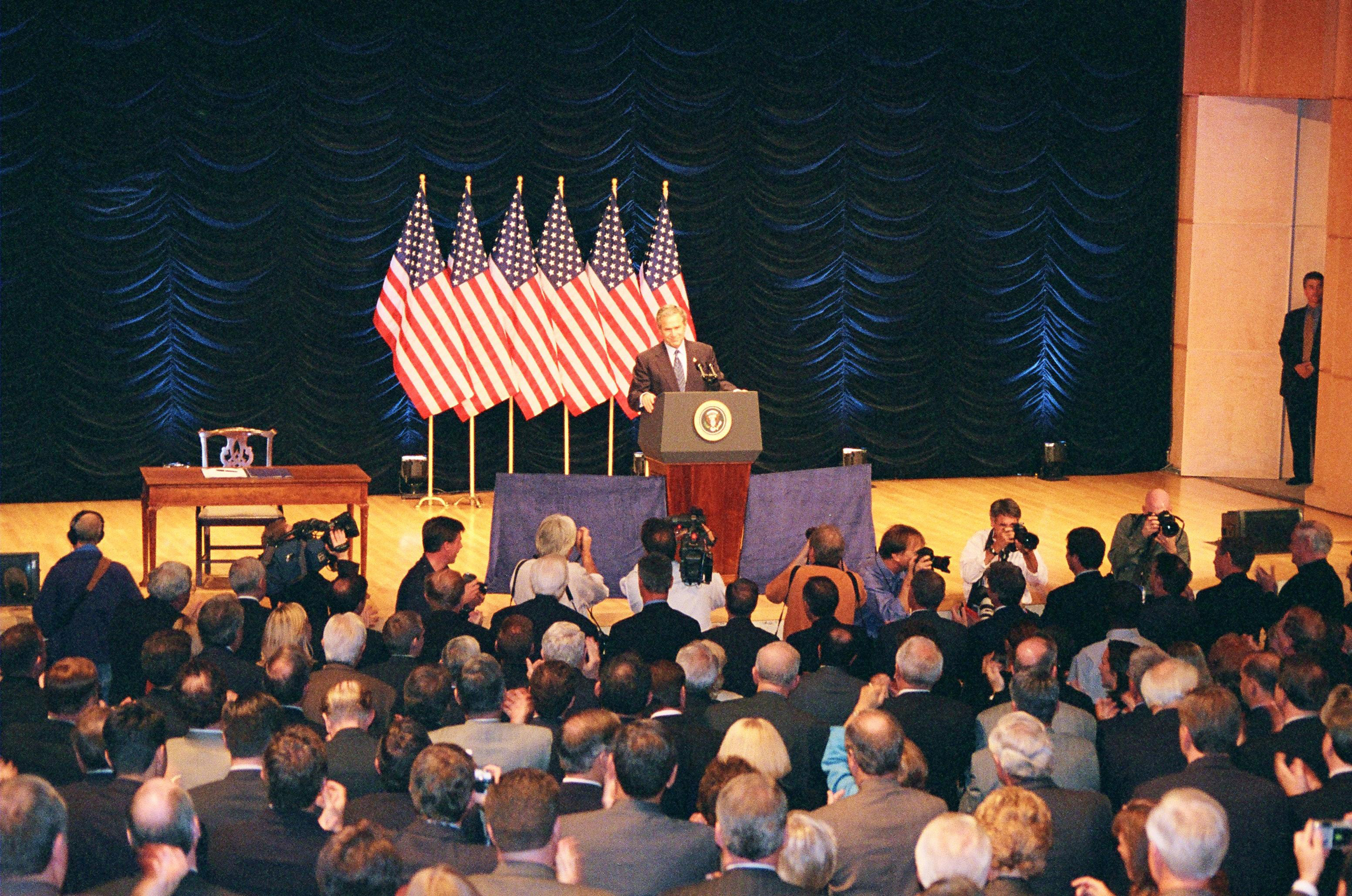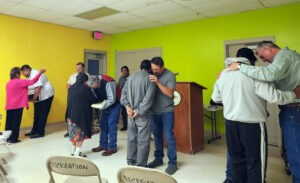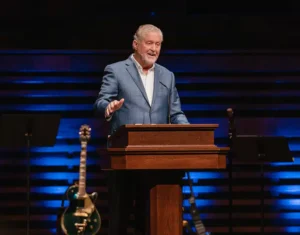
WASHINGTON (BP)–“For years, a terrible form of violence has been directed against children who are inches from birth, while the law looked the other way,” President Bush told an enthusiastic audience of about 400 people, including many members of Congress, prior to signing the Partial-birth Abortion Ban Act Nov. 5.
“Today, at last, the American people and our government have confronted the violence and come to the defense of the innocent child.”
Bush’s signature — on the first restriction on a particular procedure since the Supreme Court legalized abortion 30 years ago — enacted a ban first introduced in 1995 and vetoed twice by former President Clinton.
The new law bars a procedure that has been a focus of much of the abortion debate during the last decade. The method involves the killing of a nearly totally delivered baby normally in at least the fifth month of pregnancy.
It took less than an hour after the signing ceremony, however, for a judge to block enforcement of the new law in a limited fashion. Federal Judge Richard Kopf of Nebraska issued a temporary restraining order against the ban but applied it only to the four doctors who brought the suit, according to the Associated Press.
Then, on Nov. 6, a New York judge issued a temporary order preventing the law from applying to doctors affiliated with the National Abortion Federation, which claims to represent doctors who provide half the abortions nationwide, according to AP. A federal court in San Francisco also was considering a challenge, AP reported.
The U.S. Supreme Court, which likely will rule on the law, already has struck down a state ban on partial-birth abortion.
Bush, in comments prior to signing the ban, promised that the executive branch would “vigorously defend this law against any who would try to overturn it in the courts.”
Knowing that years of court battles likely will precede the ban’s final implementation did nothing to dampen the enthusiasm of those at the signing ceremony, who frequently interrupted Bush’s speech with applause.
“The facts about partial-birth abortion are troubling and tragic, and no lawyer’s brief can make them seem otherwise,” the president said. “By acting to prevent this practice, the elected branches of our government have affirmed a basic standard of humanity, the duty of the strong to protect the weak. Our nation owes its children a different and better welcome.”
Bush said the “most basic duty of government is to defend the life of the innocent. Every person, however frail or vulnerable, has a place and a purpose in this world. Every person has a special dignity. This right to life cannot be granted or denied by government, because it does not come from government; it comes from the Creator of life.”
Southern Baptist leaders, as well as other religious and pro-life spokesmen, applauded the president’s action.
Southern Baptist Convention President Jack Graham said being at the signing ceremony “brought just an incredible wave of joy” over him.
“It is a step forward, and one that we take with a great deal of gratitude because we know it has been a long, hard battle to this point,” said Graham, pastor of the Dallas-area Prestonwood Baptist Church. “We recognize we still live in a culture of death … but thanks to the diligent efforts of thousands and thousands of Americans who believe in the sanctity of life, we were able to take this step.
“It is without question one of the most important days for life since [abortion’s legalization],” Graham said.
Richard Land, president of the SBC’s Ethics & Religious Liberty Commission, also attended the ceremony.
“Today is a landmark day in the long struggle to rekindle the vibrant flame of the sanctity of life ethic upon which this nation was founded,” Land said. “Passage of this bill is the best of news for all Americans — first, for the unborn, who will have at least some marginal protection at the very moment before birth, and second, for all citizens, since God is not going to bless a nation that countenances the barbaric and heinous act of partial-birth abortion.”
Tony Perkins, president of Family Research Council, said in a written release that Bush “did what Bill Clinton should have done in 1996, ban a barbaric procedure that is nothing short of infanticide.”
As expected, abortion-rights advocates criticized the president’s action. Kim Gandy, president of the National Organization for Women, said in a written statement that, “Today George W. Bush sends a message to every woman and girl in the United States — your reproductive rights are not guaranteed.”
Although it is the first ban on an abortion procedure since the 1973 Roe v. Wade decision, Gandy predicted “it will not be the last if George W. Bush remains in office.”
The Supreme Court’s Roe v. Wade decision, combined with a companion ruling, had the practical effect of permitting abortion for any reason throughout all stages of pregnancy.
The method now outlawed became known to the American public after Ohio abortion doctor Martin Haskell described it in a 1992 paper he presented at a seminar sponsored by the National Abortion Federation. He named it “dilation and extraction,” but pro-life advocates renamed it partial-birth abortion as they began the effort to ban it.
The procedure normally consists of the delivery of an intact baby feet-first until only the head is left in the birth canal. The doctor pierces the base of the infant’s skull with surgical scissors, then inserts a catheter into the opening and suctions out the brain. The collapse of the skull provides for easier removal of the baby’s head. This typically occurs during the fifth or sixth month of pregnancy.
In October, Congress gave final approval to the ban. The Senate voted 64-34 for the bill, while the House of Representatives approved it 281-142.
Congress twice adopted partial-birth abortion bans in the 1990s only to have Clinton veto them. In both 1996 and 1998, the House achieved the two-thirds majorities necessary to override vetoes, but the Senate fell short.
In 2000, the Supreme Court overturned a Nebraska law patterned after the federal ban approved by Congress but vetoed by Clinton. The justices voted 5-4 to strike down the law in its Stenberg v. Carhart opinion. The Nebraska measure was one of 27 state laws patterned after the federal legislation.
The high court’s ruling prompted congressional supporters of a ban to draft a new version that sought to remedy the justices’ declaration that the Nebraska law could be interpreted to cover other abortion methods. They also sought to address the justices’ ruling the ban needed an exception for maternal health reasons. The new law provides more specific language on the procedure it seeks to prohibit. It also declares in its findings the method is neither safe for women nor necessary to preserve their health. It includes an exception to protect the mother’s life.
The Southern Baptist Convention approved resolutions condemning the procedure in both 1996 and 2002. Last year, messengers easily passed a proposal from the floor calling for Bush to make enactment of a ban on the method a high priority.
–30–
(BP) photos posted in the BP Photo Library at http://www.bpnews.net. Photo titles: PRO-LIFE APPLAUSE and READY FOR THE DEFENSE.

















